当前位置:网站首页>MySQL - database query - use of aggregate function, aggregate query, grouping query
MySQL - database query - use of aggregate function, aggregate query, grouping query
2022-07-04 20:53:00 【Sauerkraut】
Aggregate functions ( Statistical function )
SQL Allow calculation of data in the table , Take each column of data in the table as a whole , Do the longitudinal calculation .
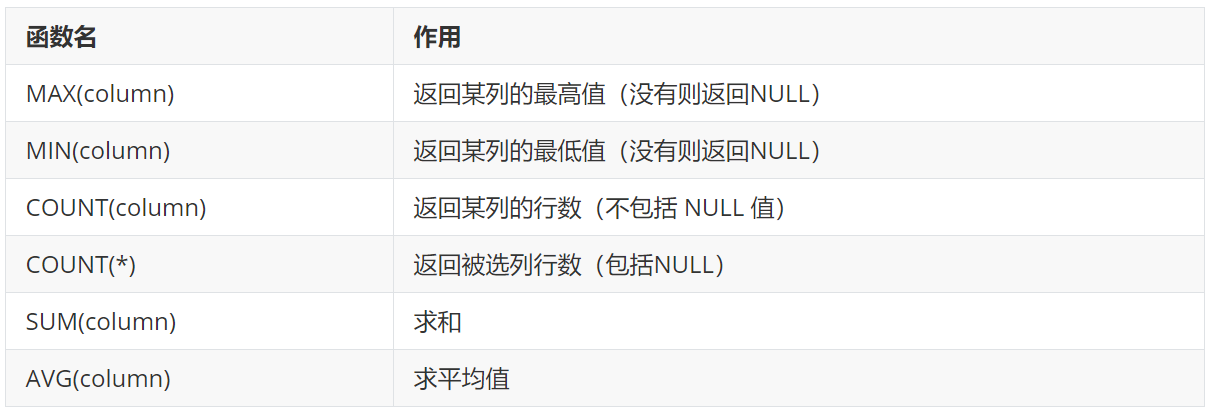
column Indicates the field name , Perform some operations on a certain field
MAX、MIN、COUNT Null values are not calculated
COUNT(*) Returns the number of rows in all columns , Contains a null value
among COUNT Function can be used for any data type ( Because it only records the number of lines ), and SUM 、AVG Functions can only evaluate numeric types ,MAX and MIN Can be used for numerical 、 String or date time data type .
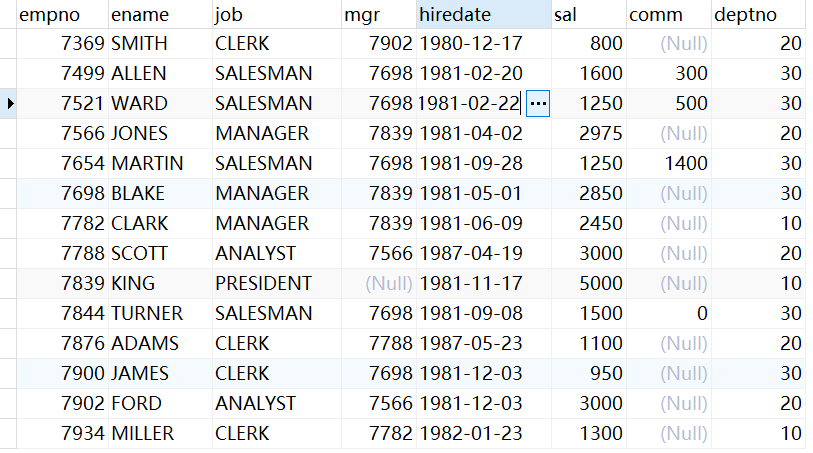
1. Count the number of employees in the enterprise
SELECT COUNT(*) FROM emp;
Be careful COUNT() Null values are not included
SELECT COUNT(mgr) FROM emp;
2. Count the average salary of employees in the enterprise
SELECT AVG(sal) FROM emp;
3. Query the maximum salary of employees in the enterprise
SELECT MAX(sal) FROM emp;
4. Query the minimum wage of employees in the enterprise
SELECT MIN(sal) FROM emp;
5. Calculate the sum of wages for all sales
SELECT sal FROM emp WHERE job='salesman';
SELECT SUM(sal) FROM emp WHERE job='salesman';

Group query
Aggregate functions are actually statistical functions .
Next, let's learn about grouping statistical query .
One thing to declare is that , Although statistical functions are generally combined with grouping queries , But there must be some cases of using it alone . for example : Basic paging operations when doing report display , Be sure to find out all the data .
So what is grouping ?
The concept of grouping is actually very common in life , For example, there are the following requirements :
1. In a class , Ask men and women to compete in a debate
2. In the company , Each department is required to compete in a tug of war
For the first demand , Suppose there is a student table , Then there must be a gender field in the student table , The gender can only be male or female .
And in the company , If you want to group departments , There must be duplication in the contents of a department column . Departments and employees have a one to many relationship , A Department corresponds to multiple employees .
Grouping is meaningful only for fields with duplicate data , We can check emp surface , Find the field positions that can be grouped job And department number deptno.

First, employee number empno It can't be repeated , If I repeat , It's the same person , full name ename Generally, there will be no repetition
grammar
GROUP BY Then write which field to group
HAVING Filter the grouped data after grouping
WHERE Filter the data before grouping
HAVING Filter the data after grouping
SELECT Grouping field / Aggregate functions FROM Table name [WHERE Conditions ] GROUP BY Grouping field [HAVING Conditions after grouping ];Query requirement
1. Count the number of people in each job , Output all jobs , Then group it , Multiple repetitions are in a group , Finally, count the number of people in each group
SELECT job,COUNT(*) FROM emp GROUP BY job;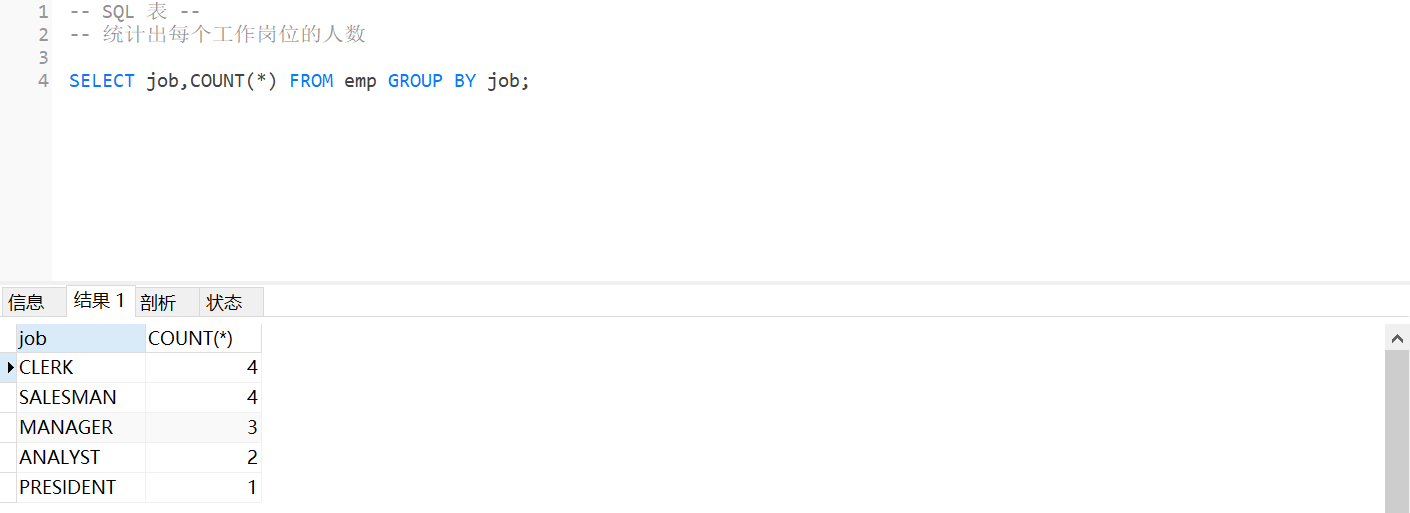
2. Count the minimum and maximum wages for each position
-- Count out each position
SELECT job FROM emp GROUP BY job;
SELECT job,MIN(sal),MAX(sal) FROM emp GROUP BY job;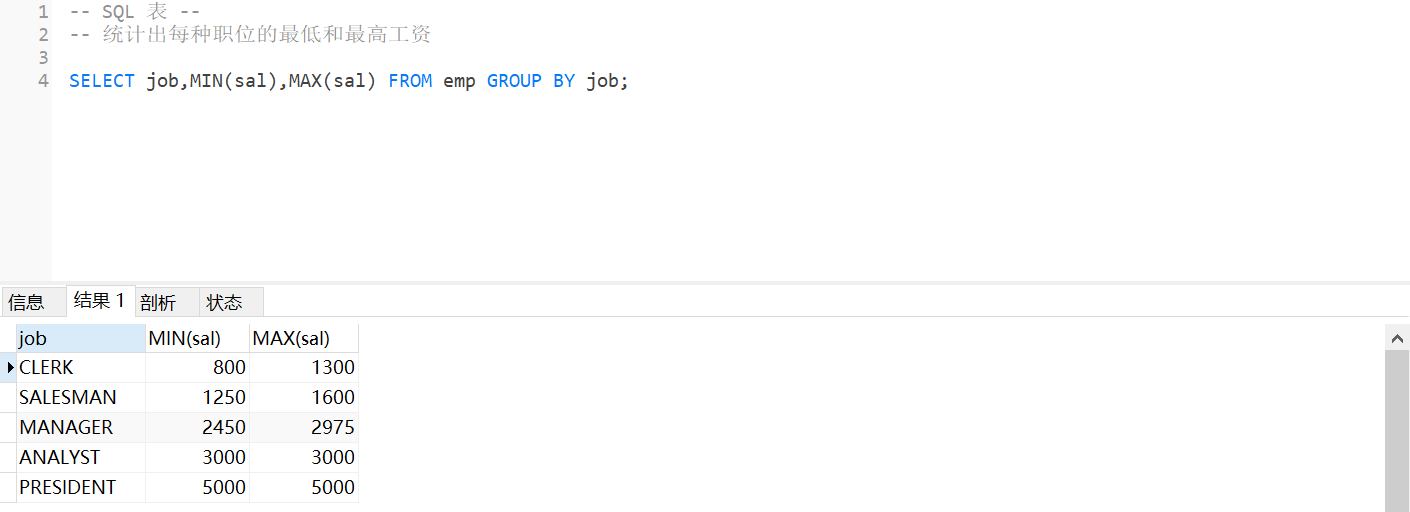
The above two queries realize the basic operation of grouping , And these codes are written in standard format . But in the Group , Personally, I think the most troublesome thing is the restrictions of grouping operation .
matters needing attention
1. If a query ( non-existent GROUP BY Clause ), So in SELECT Only statistical functions are allowed in Clauses , No other fields are allowed .
When there is a statistical function , No other fields are allowed .
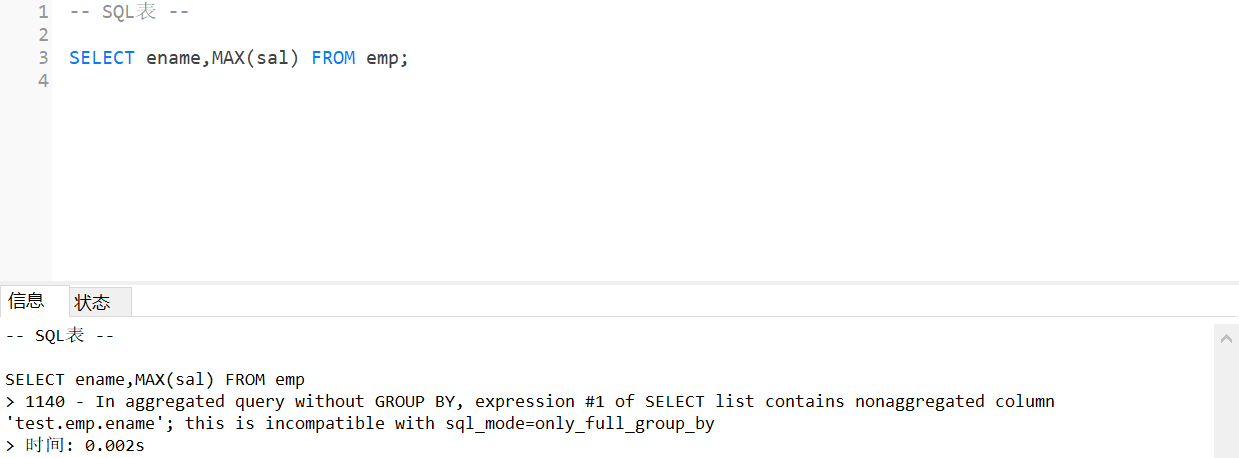
# Wrong statement
SELECT ename,COUNT(job) FROM emp;
# The right sentence
SELECT COUNT(job) FROM emp;2. In statistical query ( There is GROUP BY Clause ),SELECT Only statistical functions and grouping fields are allowed in Clauses (GROUP BY Fields defined later ), No other fields are allowed .

# Wrong statement
SELECT ename,COUNT(job) FROM emp GROUP BY job;
# The right sentence
SELECT deptno,COUNT(job) FROM emp GROUP BY job; When grouping later , On one principle :GROUP BY The allowed fields in the clause are SELECT Allowed fields in Clause .
Query requirement
1. Display the salary of different positions less than 1500 The number of people
-- Show different positions
SELECT job FROM emp GROUP BY job;
-- Show the number of people in different positions
SELECT job,COUNT(*) FROM emp GROUP BY job;
-- Display the salary of different positions less than 1500 The number of people
SELECT job,COUNT(*) FROM emp WHERE sal<1500 GROUP BY job;
2. Add one more restriction , Only show the number of people greater than 2 Of , In fact, No 1 The result of the question will be screened again
SELECT job,COUNT(*) FROM emp WHERE sal<1500 GROUP BY job HAVING COUNT(*)>2;
3. Show non salespeople (salesman) The sum of the job name and the monthly salary of employees engaged in the same job , And the total monthly salary of employees engaged in the same work shall be greater than or equal to 5000
SELECT job FROM emp WHERE job!='salesman';
SELECT job,SUM(sal) FROM emp WHERE job!='salesman' GROUP BY job;
SELECT job,SUM(sal) AS total FROM emp WHERE job!='salesman' GROUP BY job HAVING total>=5000;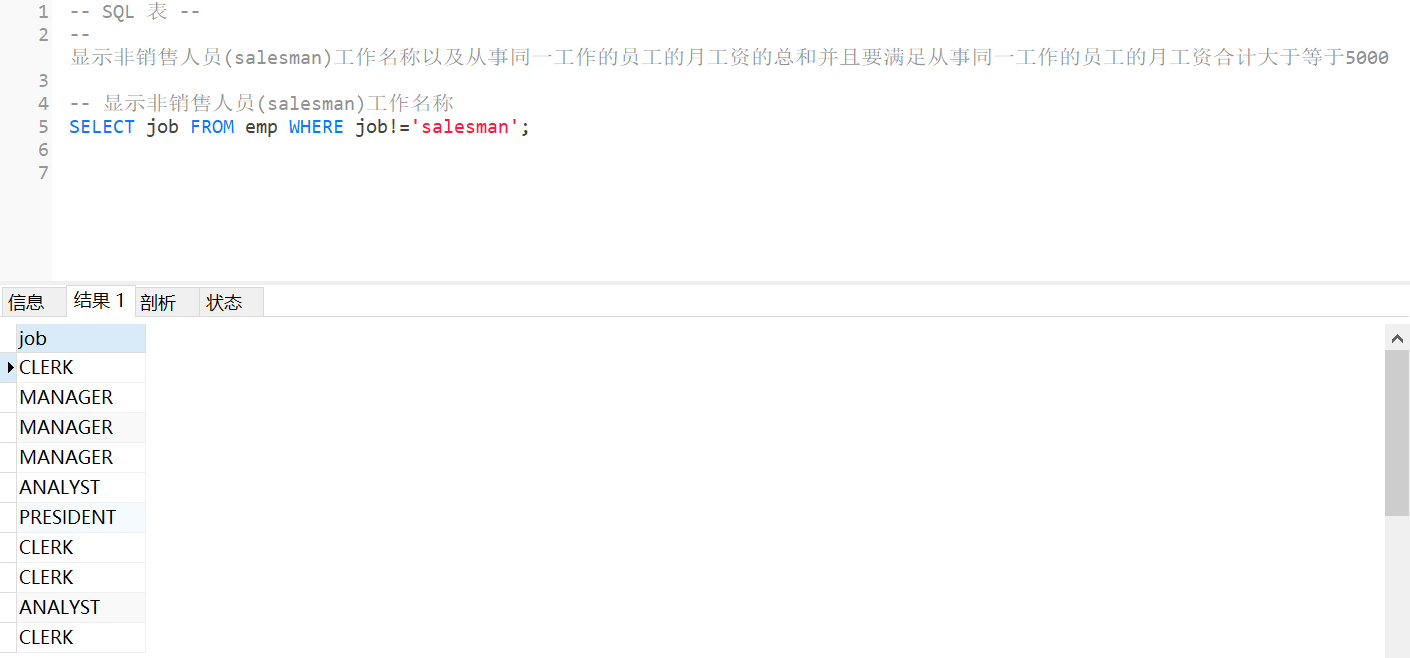
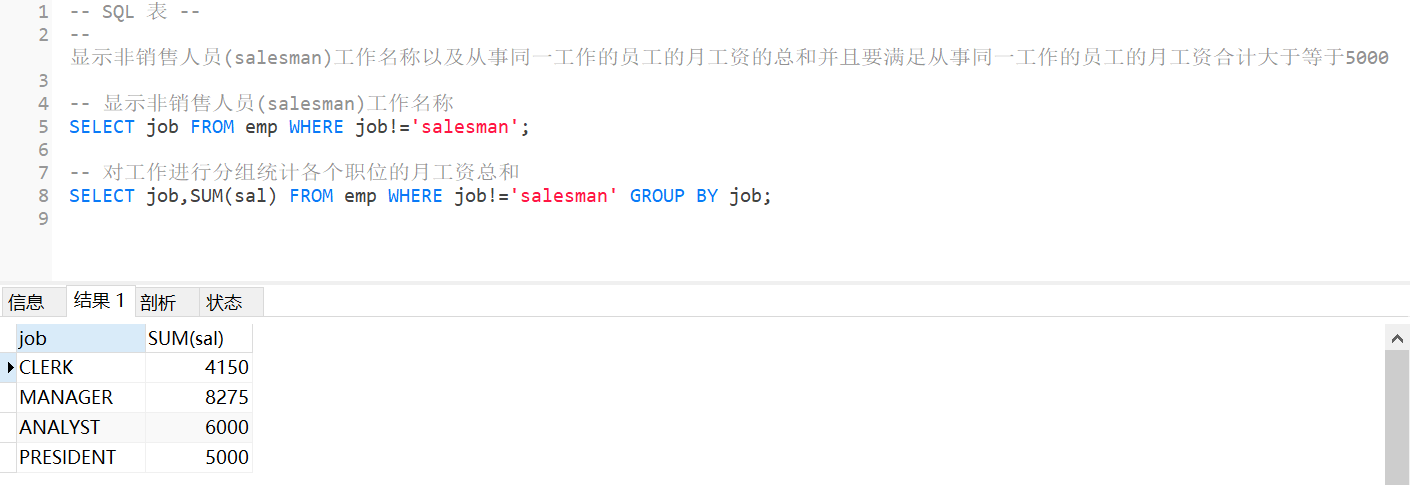


WHERE and HAVING difference
WHERE: Is to use... Before grouping ( There can be no GROUP BY), Statistical functions are not allowed .
HAVING: Is used after grouping ( Must be combined with GROUP BY), Statistical functions are allowed .

边栏推荐
- FS8B711S14电动红酒开瓶器单片机IC方案开发专用集成IC
- Win11亮度被锁定怎么办?Win11亮度被锁定的解决方法
- 实践示例理解js强缓存协商缓存
- What if the WiFi of win11 system always drops? Solution of WiFi total drop in win11 system
- 托管式服务网络:云原生时代的应用体系架构进化
- 最长的可整合子数组的长度
- 记一次重复造轮子(Obsidian 插件设置说明汉化)
- 奏响青春的乐章
- 栈:如何实现有效括号的判断?
- What should I do if my computer sharing printer refuses access
猜你喜欢

How does the computer save web pages to the desktop for use

hash 表的概念及应用

Automatic generation of interface automatic test cases by actual operation
一文搞懂Go语言中文件的读写与创建
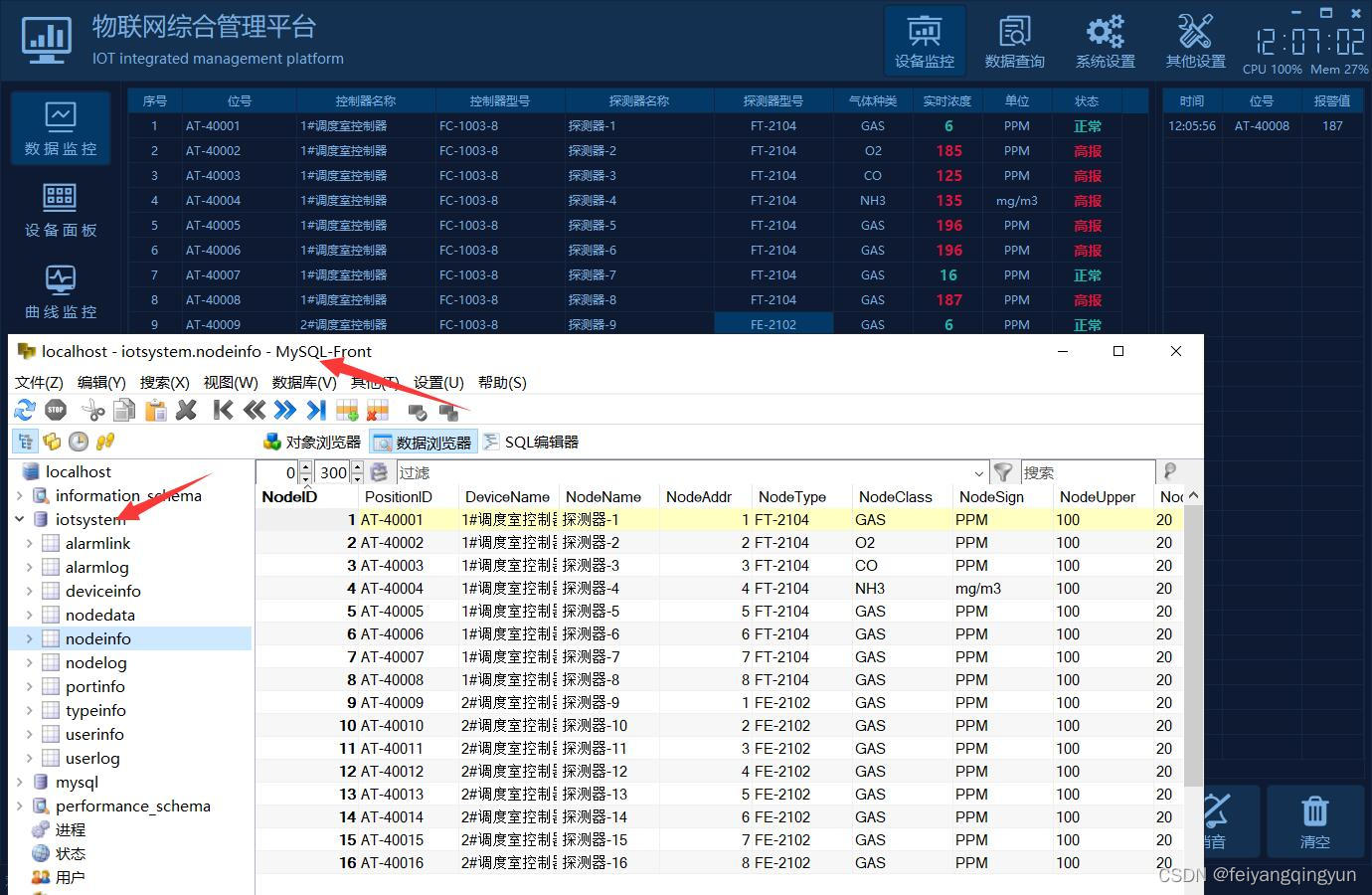
QT writing the Internet of things management platform 38- multiple database support

How to adapt your games to different sizes of mobile screen

Selected review | machine learning technology for Cataract Classification / classification

From automation to digital twins, what can Tupo do?

Win11无法将值写入注册表项如何解决?

Hands on deep learning (III) -- convolutional neural network CNN
随机推荐
Integretee integrates into Moonriver through xcm, bringing enterprise class privacy solutions to its ecosystem
What if the win11 shared file cannot be opened? The solution of win11 shared file cannot be opened
What if the brightness of win11 is locked? Solution to win11 brightness locking
Understand Alibaba cloud's secret weapon "dragon architecture" in the article "science popularization talent"
黄金k线图中的三角形有几种?
BFC面试简述
Oracle database, numbers Force 2 decimal places to display-Alibaba Cloud
什么是区块哈希竞猜游戏系统开发?哈希竞猜游戏系统开发(案例成熟)
Cdga | six principles that data governance has to adhere to
长城证券开户安全吗 股票开户流程网上开户
记录线上bug解决list(未完待续7/4)
Jiuqi ny8b062d MCU specification /datasheet
NetCore3.1 Json web token 中间件
LeetCode 8. 字符串转换整数 (atoi)
Taishan Office Technology Lecture: about the order of background (shading and highlighting)
jekins初始化密码没有或找不到
LeetCode 7. 整数反转
阿里测试师用UI自动化测试实现元素定位
NLP, vision, chip What is the development direction of AI? Release of the outlook report of Qingyuan Association [download attached]
左右最值最大差问题
